2005 VOLKSWAGEN GOLF belt
[x] Cancel search: beltPage 148 of 444

2.1
seats can help protect toddlers and children ove r
age 1 and and up to
mately lbs. (9 and 18 kg) in a cra sh.
Fig . 32
stall a child seat, yo u must first activ ate the
switchable locki ng feature on the safet y
belt to pre vent the child seat from moving
63.
-the child seat down with your full
weight to get the safety belt re ally tight so
that the seat cannot move fo rw ard or
page 69) to
the tether anchorage for th e seating
tion w here the c hild restra int is being
sta lled page 68.
-
safety
A toddle r or is usuall y too large for fant restraint, if it is m ore than one year and weighs more than 221b s.
and weig h be tween 221bs.
s train ed in seat certified for the ir size and fig. 32.
The airbag on the passenger side m akes the front seat a pot entially dang erous place fo r a to ride. Th e front seat is not the safest place
for a child in a forward-fac ing child seat.
in a re arw ard-facing seat.
WARNING
Not using us ing the wrong seat or improperly installing child restra int
increases the risk of serious personal injury and death in a or other emergency
si tuation.
Children on th e front seat of any car, even
with Advanced Airbags, can be seriously jured or even
be seriousl y
in jured and be if th e front airbag flates-even with an Advanced 1\irbag System .
The inflating airbag will th e child seat or infant carrier with gr eat force and
Always install rearward -facing child seats on the rear seat.
yo u must i.nstall a rearward faci ng sea t on the front passeng er sea t because of ceptional circumstances and th e PASSENGER
immediatel y in stall the r earward-facing
child sea ting position and have
th e airbag system inspected by your rized Volkswagen dealer or qualified work-
shop.
Page 150 of 444
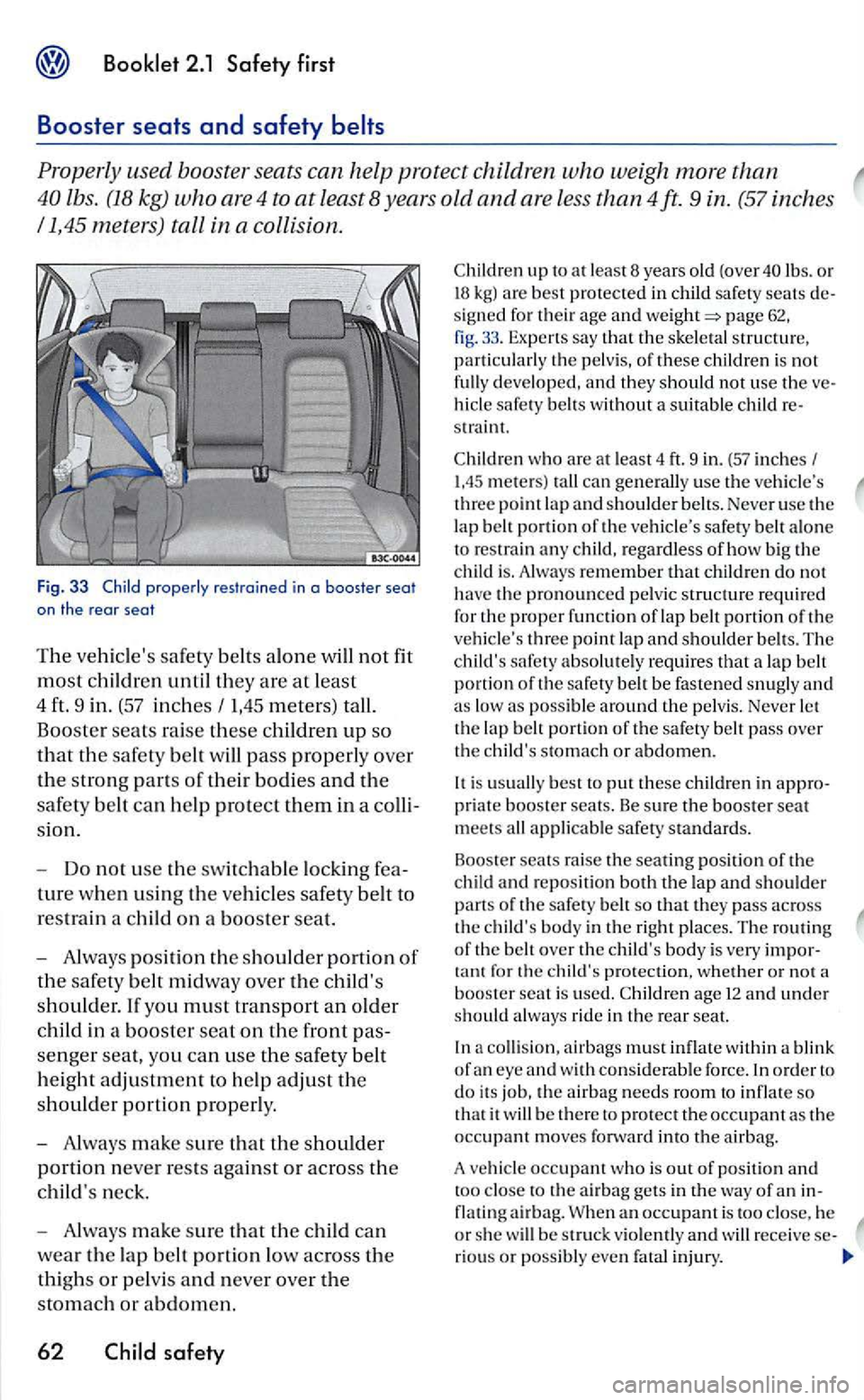
Properly used booster seats can help protect children who weigh more than
lbs. (18 kg) who are 4 to at least 8 years old and are less than 4ft. 9 in. (57 inches
1,45 meters) tall in a collision.
Fig. 33 Child
s igne d for th e ir age and page 62, fig. 33. Experts say that the skeletal structu re, particularl y the pelvis, of these child ren is not fully developed, and
1,45meters) tall can generally use the vehicle's three point lap and shoulder belts. Never use the lap be lt portion of the vehicle's safety belt alone to res train any child, regardless of how b ig the child is. Always remember that children do not have the pronounced pelvic structure requ ired for the proper fun ction of lap belt portion of the veh icle 's three point la p and shoulder belt s. The child's safety absolutely require s that a lap belt portion of the safety belt be fas tened snugl y and as low as possible around the pelvis. Never le t the lap b e lt portion of the safety belt pass over
the ch ild's stomach or abdomen.
age 12 and under should always ride in th e rear seat.
a c ollisio n, airba gs must inflate w ith in a blink
o f an eye and w ith considerable force. ord er to
d o its job , the airbag needs room to infla te so tha t it will be there to pro tect the occupant as the occupant moves forward into the airbag.
A vehicle
occupant who is out of posit ion and too close to th e airbag gets in the way of an infla tin g airbag. When an occupant is too close, he
o r she will be stru ck vio lently and wiLl receive se-rious o r poss ibly even fatal injury.
Page 151 of 444
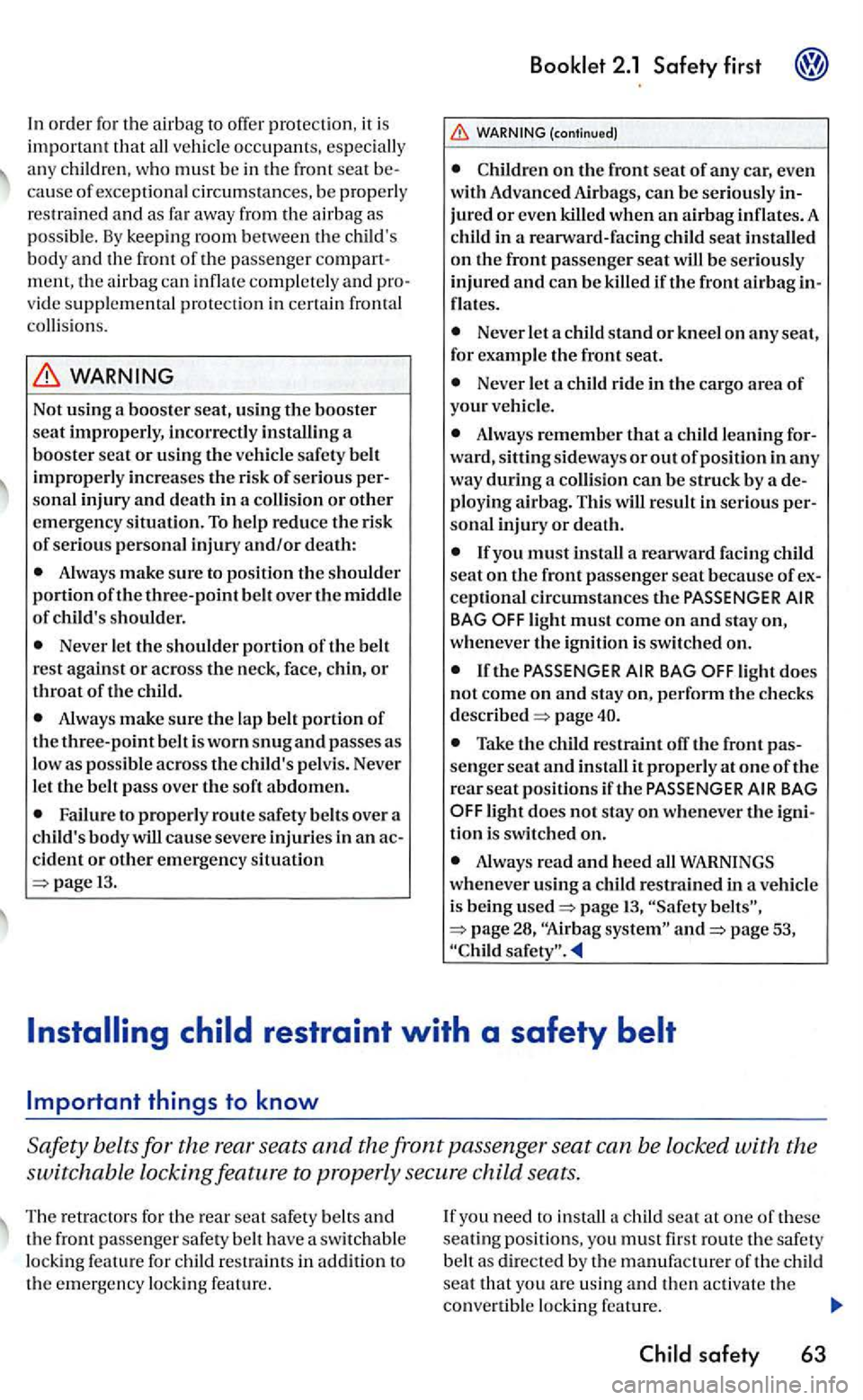
In order fo r th e air bag to otTer prote ction , it is
important that ve hicle occupants, es peciall y
a ny children , who must be in the front seat cau se of e xc e ptional circum stances , be prop erl y
r es trained and as far away from the airb ag as
possible. B y keep ing room be tween th e ch ild 's body and the front of the passe nger ment, the airbag can inflate complet ely and vid e supplemental protection in ce rtain frontal
c olli sions.
Not usi ng a booster seat, usin g the booster seat improperl y, incorrectly installing a booster seat or using the veh icle safe ty belt
improperly increases the risk of serious sonal injury and death in a or other em erg ency situation. To help reduce the risk of serio us personal injury and/or death:
Always make sure to position the shoulder portion of the three-point belt over the middle of child 's shoulder.
Neve r let the shoulder portion of the belt
res t against or across the neck, face, chin, or throat of the child.
Always make sure the lap belt portion of the three-point belt is worn snug and passes as low as possible across the child' s pelvis. Never
let the belt pass over the sof t abdomen.
Failure to properly route safety belts over a child's body will cause severe injuries in an
13.
(continued)
Childre n on the front seat of any car, eve n
with Advanced Airbags, can be seriously jured or even killed when an airbag inflates. A
child in a rearward-facing child seat in stalled on the front passenger seat will be seriously
injured and can b e killed if the front airbag flate s.
Never le t a child stand or kneel on any seat, for example the front seat.
Never let a child ride in the cargo area of your ve hicl e.
Always remember that a child leaning
ploying airbag. This will result in serio us sonal injury or death.
lig ht does not come on and stay on, perform the checks page
Take the child restraint off the front senger seat and AIR BAG light does not stay on whenever the tion is swi tc h ed on.
A lwa ys read and heed all WARNINGS w henever usin g a child restrained in a vehicl e
is being page 13, page 53,
safety 63
Page 152 of 444
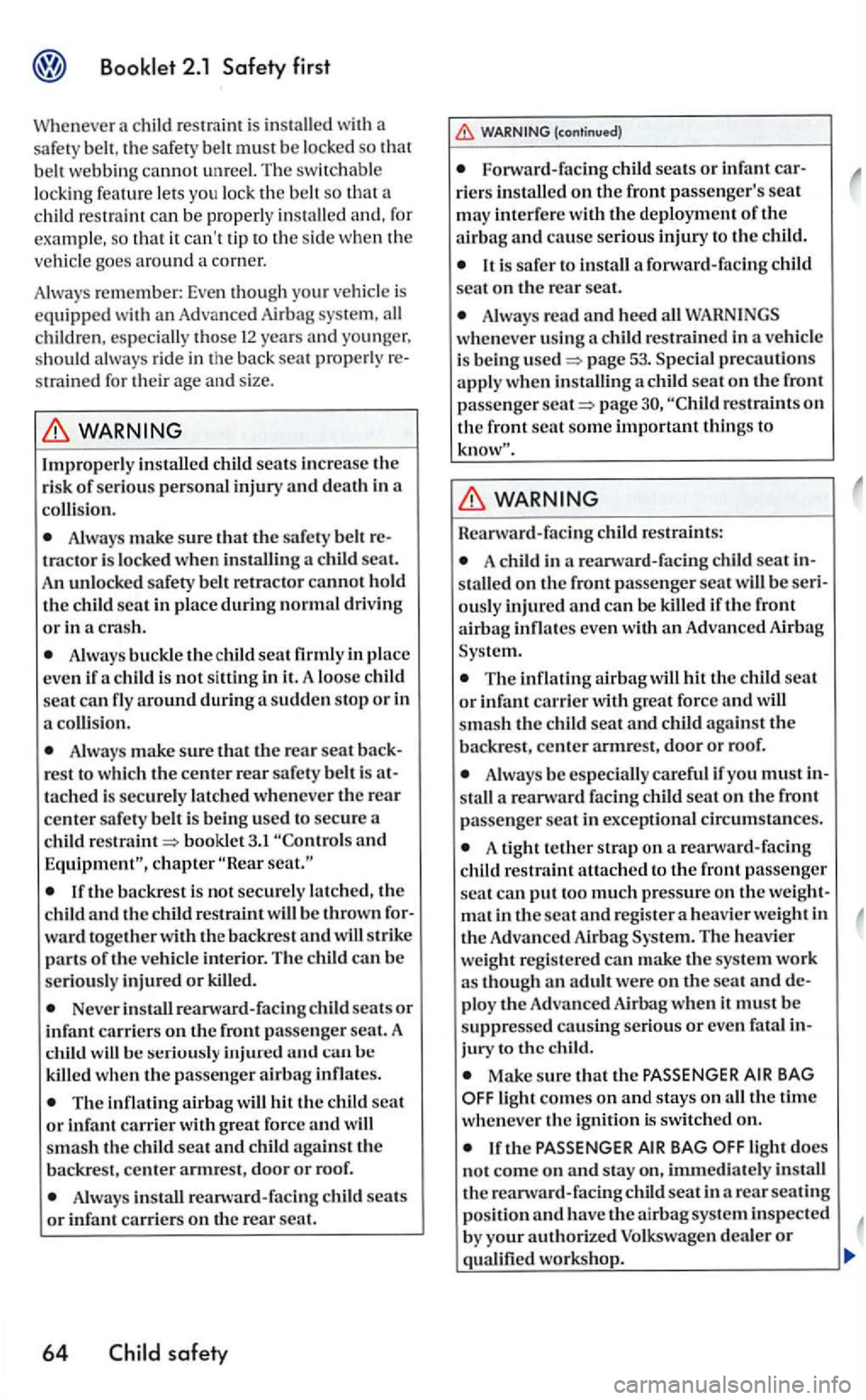
child restrain! is in stalled with a
sa fety belt , th e safety belt must be locke d so
strained for th eir age and size.
colli sio n.
Always make sure th at the safety b elt tracto r is locke d w hen in stallin g
Always buckle the seat firml y in plac e
eve n if
can fly around during a sudden sto p or in
Always rest to whi ch the ce nter rear safety belt is tach ed i s sec ure ly la tc h ed wh eneve r th e rea r
cente r sa fety belt is being use d to secure a
c hild booklet 3.1 and
ward together with the backrest and w ill strik e
part s of th e ve hicl e int eri or. T he c hild can be seriou sly injure d or kill ed .
Never ins tall rearw ard -faci ng c hild scats or infant carri ers on the f ront passe nge r sc at. A
kill ed w hen the passe nge r airb ag inflates.
The inflatin g air bag will hit the child scat or infa nt carrier with great force and w ill
smas h th e child seat and child against the
b ackrest, ce nter armrest , d oo r or roof.
Always instal l rearward -faci ng c hild seats or infant carri ers on th e rear scat.
64 safety
Forward -facin g c hild seats o r infant ri ers insta ll ed on the fr ont passe nger' s sca t
m ay interfere with the de plo ym ent of the
a irba g cause seriou s injury to the c hild.
Alw ays read and hee d all whenever u sin g a c hild restrain ed in a vehicle
i s be in g page 53.
page
Rearward -fa cin g restrai nts:
child in a reanva rd-facin g c hild seat sta ll ed on the front p asse nger sea t will b e ously inju red and ca n be killed if the fro nt
a irbag infl ates eve n with an Advan ce d Airb a g
Syste m.
The inflatin g airbagwill hit the child seat or infant carrier with great force and w ill
smas h the c hild seat a nd child against the
b ackrest, ce nter armres t, d oor o r r oof.
Always be es peci all y care ful if yo u must s tall a reanvard faci ng seat on the front pa sse nge r seat in ex ce ptional circumsta nces.
A tight te th er strap on a rearward- fac ing
c hild restraint attache d to the front p asse nger
sca t can put too muc h pressure o n the mat in the seat and reg is ter a heav ie r weight in the A dva nce d Airb ag Sys te m. The hea vie r
w eig ht reg is te re d ca n mak e th e sys te m work
as
thoug h an adult were o n the scat and ploy the A dva nced Airba g wh en it must be suppresse d causing serio us or eve n fa ta l ju ry to the child .
Make sure that th e PASSENGER AIR BAG Light comes o n and s tays on all the tim e
wh en ever th e ig niti on is s wit ch ed on.
dealer o r
Page 153 of 444

WARNING
An imprope rl y in sta lled child ca n interfe re w ith the airba g as it de ploys and se riously inju re or eve n kill the c hild -eve n w ith an Advan ced Airbag Sys te m .
m ent pan el.
Booklet 2.1 Safety first
(continued)
- Always move the passenge r scat int o its
reannos t pos ition in the sea t's fo re and aft
a dju stment range, as fa r away fr o m th e
a irbag as p oss ible befo re i nstalli ng the fo r
ward- faci ng c hild res tra .int. The backrest must be adjusted to an uprigh t posi tion.
- Always
make sure th at nothi ng p reve nts
t h e fro nt passenge r's seat fro m being moved to the rearmost p osit ion in its fore
a nd a ft ad justment r an ge.
- Neve r pl
ace ite ms o n th e seat th a t ca n the to ta l we ight regis
t e re d by the weight-sensin g and ca n
cause injury in a cras h.
Make sure that th e PASSENGER AIR B A G the time wheneve r the ignition is swi tche d on.
light d oes
n o t come o n and stay on , i mmediate ly install the forwa rd-fa cin g child seat in
th e seat man
ufacturer's i nstructio ns w he n
res traint in your
th e
s
peci a l in struct ions and heed the WARN
INGS below. To activa te t he switchable
lock ing fe a ture:
-
t h e c hild res traint on a seat, pref
e ra bl y on th e r
ear
-Set the safety belt upper anchorage for
the fron t passenger seat to the highest ad
justment position if t he availab le safety
be lt le ngt h is s
ufficient to properly
the child
- Move the front passenger seat t o the
hig h es t position in th e seat's up and down
adjustment rang e.
- Move
the front passenger seat to there
armost position in d1e seat's fore and aft
adjustment range, as far away from the
ai r
bag as possible before the for
ward-facing child
restrai nt.
-th e child res tra int on a seat, pref
erably on the rea r
-Houte th e safety belt around or through
th e
C hild safety 65
Page 154 of 444

the c hild restraint down with your
full weight to make sure that the child re
straint will be prope rly ins tall ed wi th the
safety belt really tight.
- Sl
owly pull the should er belt portion of
the safe ty belt all t h e way out of the re
tractor.
- Wh
ile keeping your weight o n the
restraint, guide the should er belt portion
o f
the safety bac k into the retrac tor
until the belt lie s flat and is tig htened
aga inst the child restra int.
-should hear a noise as
the b el t wi nd s back int o the in ertia reel of
the safe ty belt retrac to r. Test the swit ch
able lockin g feature by pulling on the belt.
should no lo nge r be able to pull th e
b elt o
ut of the retrac tor. The switc hable
lockin g feature is now activ e.
-
on the belt to make sure the s afety
belt is properly fas te ned and tight.
-
safety
- After checking to make sure that the
child restraint is properl y installed make
cenain that the child restraint is correctl y
recognized by the weight-sensing mat in
side the front passenger seat, so that the
front passenger airbag status is always cor
rectl y signale d by th e PASSE NG ER AIR
B A G light. be sure to read the
additional imponant information and
heed the WARN INGS ab out th e Advanced
Airbag System and the function of the
P
ASSENGE R AIR BAG
WARNING
Using the w rong child restraint or an improperly installe d child restraint can ca use seriou s personal injury or death in an accident.
Always make sure th at the safe ty be lt re
tractor is locked when i nsta llin g a child seat. An unlocked safe ty belt retrac tor cannot hold the child seat in place during normal drivi n g or in a crash.
Always buckle the child scat firm ly in place
even if a child is not siltin g in it. A loose chil d
seat can fly around durin g a sudden stop or in
a collision.
Alwa ys make su re th e seat backre st to
which th e child restra int is ins talled i s in an upright pos ition and sec urel y latched into
p la ce and cannot fold fo rward. Otherw ise, the seat back with the chil d seat attac hed to it
c o uld fly forward in the eve nt of a co llision or other emergency situation.
Alwa ys read and heed all WARN INGS wh en ever using a child res train ed in a vehicle
i s being page 53. Specia l precautions apply when installing a child scat on th e fro nt passenger page restraint s on the front scat some important thin gs to
Page 155 of 444
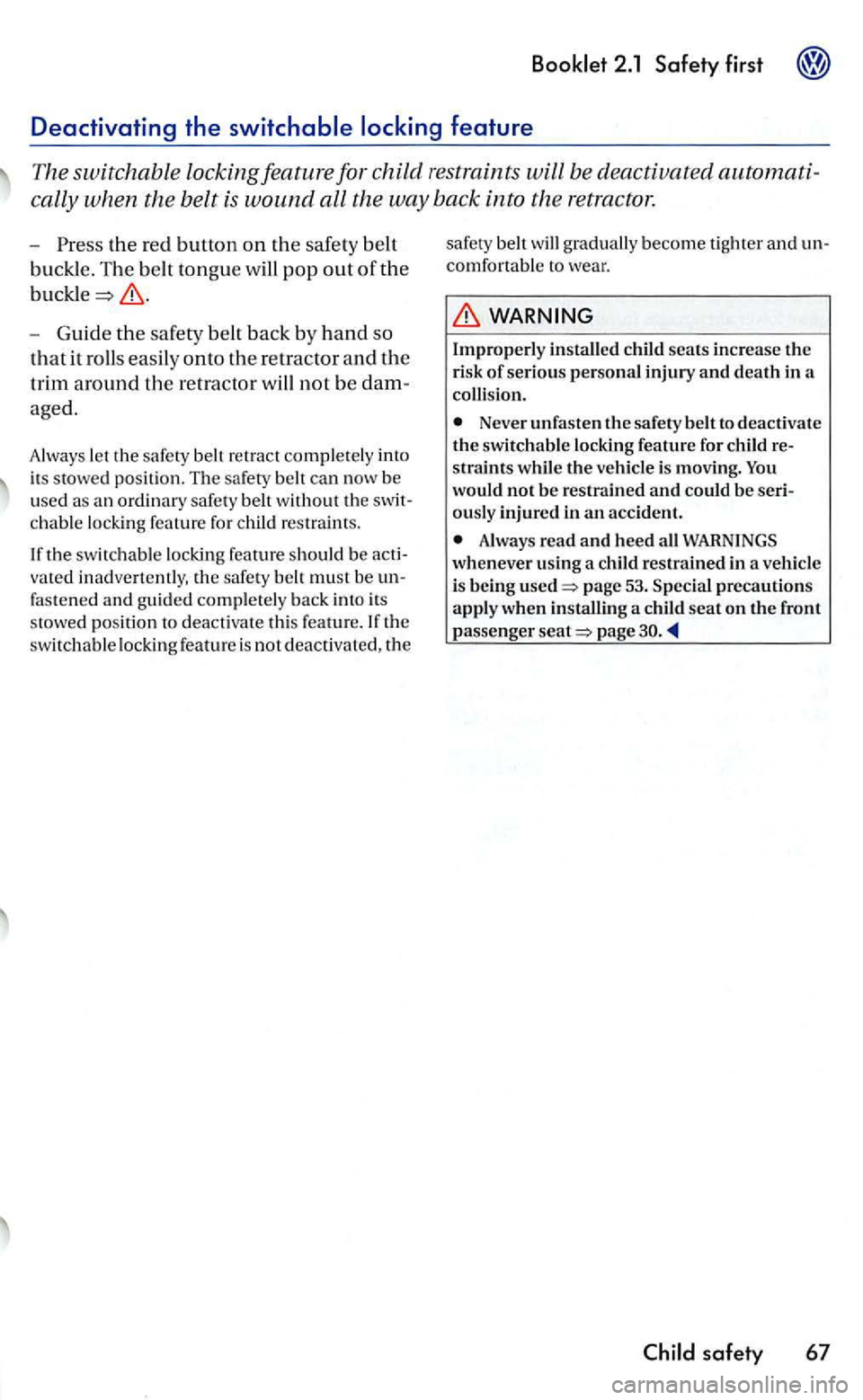
2.1 Safety first
cally when the belt is wound all the way back into the retractor.
-the red button on the safety belt
buckle.
The belt tongue will pop out of the
-Guide the safety belt back by ha nd so
that it rolls easily onto the retractor and the
trim around the retractor will not be
aged.
Always let th e sa fe ty belt retract completely into its s towed position. The sa fety belt can now be used as an ordinary safety belt withou t th e
vated inadvertently, the safety belt must be
WARNING
Improperly installed child seats increase the risk of serious personal injury and death in a
collision .
Never unfasten the safety belt to deactivate the switchable locking feature for child
ously injured in an accident.
WARNINGS whenever using a child restrained in a vehicle
i s being page 53. Special precautions apply when installing a child seat on the front passe ng er page
safety 67
Page 156 of 444
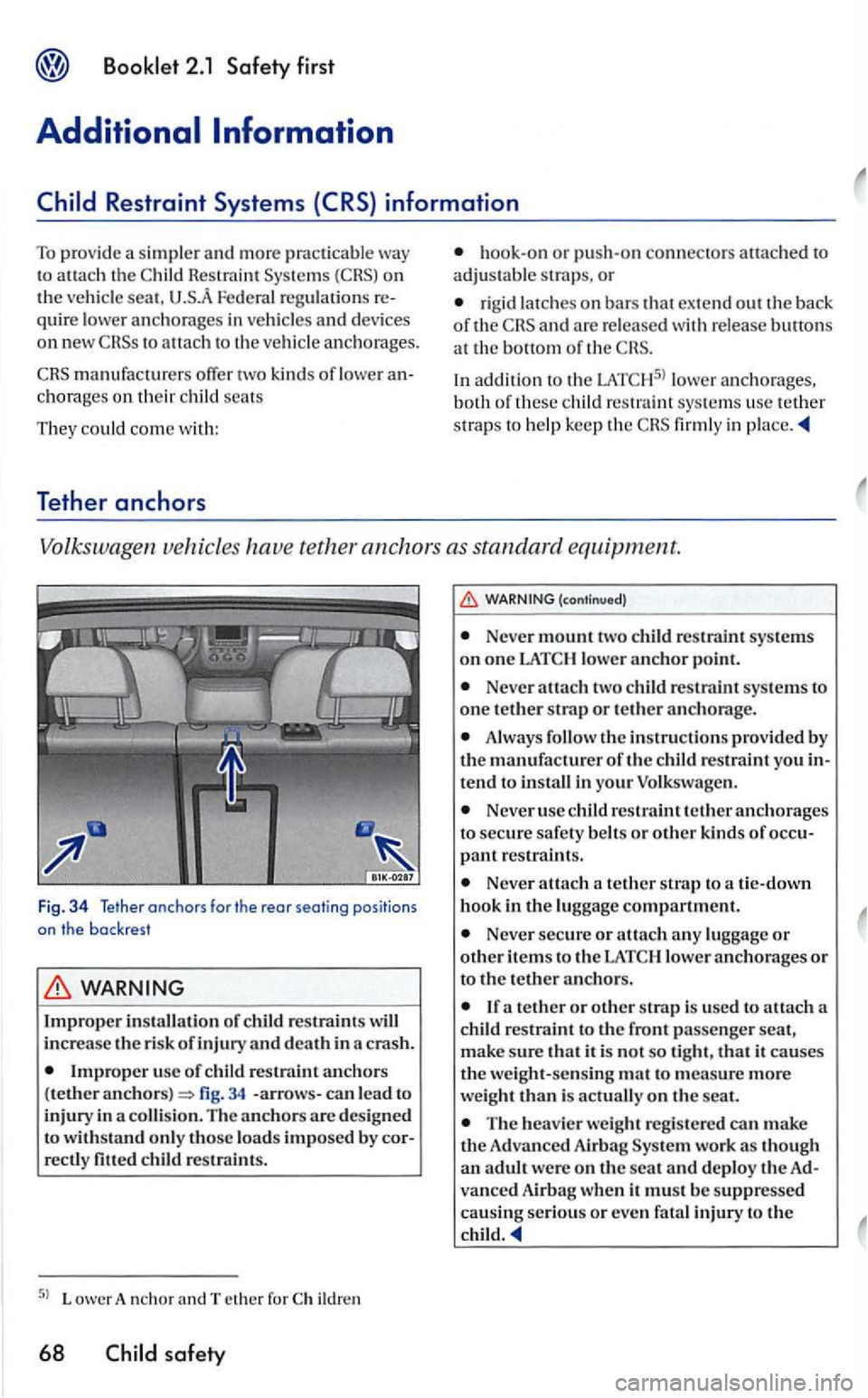
to attach the Res tra int on th e veh icle seat. Fe deral regularions quire lower anchorage s in vehicle s and devices to attac h to th e ve hicle anc horages.
ch o rage s on their chi ld sea ts
They could come w ith :
Tether anchors
hook-on or pu sh- on con nec tors att ached to
adjustable straps, or
rigid latc hes on bars that exte nd out the back of the e ns and are re lease d with release butto ns at th e bo tto m of th e ens.
I n add
ition to the l ower anchorages,
bo th o f thes e child res traint use te th er
stra p s to help keep the e ns firml y in place
Volkswagen vehicles have tether anchors as standa rd equipment.
Fig. 34 Tether anchors for the rear seating positions on the backres t
Improper use of child restraint anchors
( tether fig . 34 -arrows -can lead to
injury in a collision. The an ch ors are de signed
to with stand only those loads impos ed by rectly fitted child restra int s.
Lower A nch o r and Teth er for ildr en
68 safety
(co ntinu ed)
Never mount tw o child re strain t systems on one
Never att ach two child re stra int sys tems to one tether strap or tether anchorage.
Always follow the instructions pro vided by tl1e manufacturer of the c hild restrain t yo u tend to install in your Volkswag en.
Neve r use child restra int tether anch o rages
to secure safety belt s or other kind s of
Never attach a te ther to a tie-d ow n
hook in th e lugga ge compartment .
Neve r secure or attach any lug gage or oth er it ems to th e lower anchorages or
to the tether anchor s.
If a te ther or other strap is used to attach a
c hild res traint to the front passeng er seat,
m ake s ure that it is not so tig ht, th at i t ca uses the weight- sensing mat to measure more
we ight than is actuall y on the seat.
Th e heav ie r weight registe red can make Advanced A irba g work as th ough an adult were on the sea t and deploy the vanced Airbag when it must be suppresse d
causing serious or even fatal injury to th e
c hild